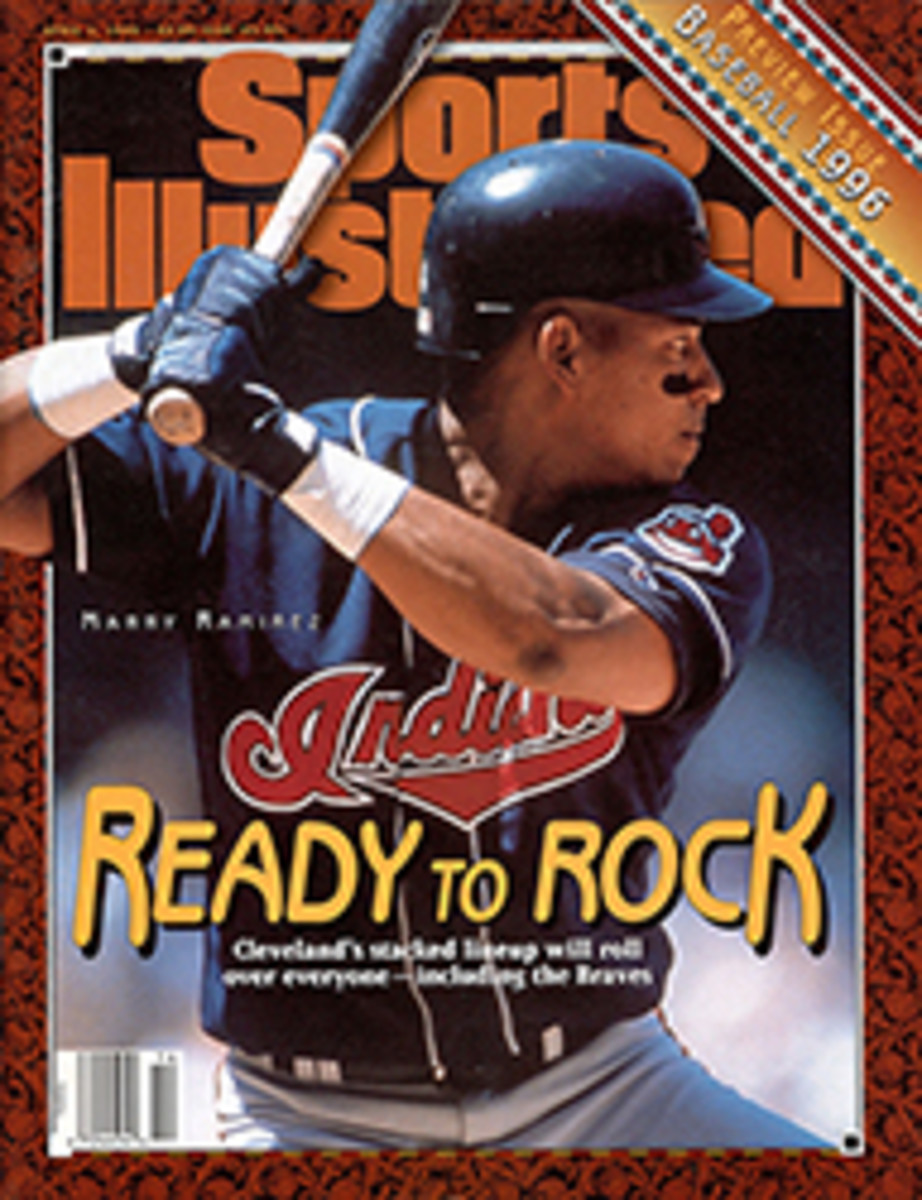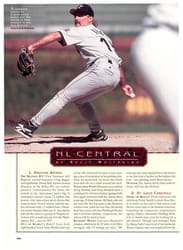
TRIPLE PLAY SCOTT MCCARRON'S UNEXPECTED VICTORY IN NEW ORLEANS CAPPED A THREE-WEEK SWEEP BY FIRST-TIME TOUR WINNERS
SCOTT MCCARRON was on his way to a five-stroke victory over poor
old Tom Watson in the Freeport McDermott Classic. It was an
amazing sight. There was Watson unraveling under the back-nine
pressure while McCarron coolly hit all the shots, as if he were
the one who had won 37 times. It was unbelievable.
"Unbelievable? Is that what you said when I was doing it last
week?" asked Paul Goydos.
Well, sure, of course we did. It did seem unbelievable that an
unknown, untested player like Goydos could play a bogey-free
weekend and win at Bay Hill. Still, by last week we should have
known better. After two months of comfortably satisfying winners
like Greg Norman, Phil Mickelson and Davis Love III, McCarron's
win was simply a part of the new trend on Tour: first-time
winners. It was started by rookie Tim Herron and his
wire-to-wire dominance at the Honda Classic. Then came Goydos,
and now McCarron, who picked up $216,000 with his win at English
Turn, outside New Orleans. Three in a row. "The baton passes,"
said Watson. "Which one of these guys who won over the last
three weeks is going to be a real star? That's the question."
It is difficult to say. All three won as convincingly as they
did unexpectedly. Herron had a fine amateur career, but the
Honda was just his eighth start on Tour. McCarron and Goydos
both struggled last year, having their best performances in the
last two tournaments of the season, earning just enough to
squeak in among the top 130 players who qualified for
exemptions. McCarron finished 128th on the money list and Goydos
129th, positions that, had five non-Tour members not been among
the group, could have stripped them of their exemptions and sent
them back to Q school.
"And what does that tell you?" asked Goydos, pausing expectantly
like the school-teacher he once was, eyebrows raised. He
answered himself: "Depth, depth--there are too many good players.
And the Tour wants to lower the exempt number to the top 115 or
top 100 or less!"
The three consecutive wins came at the time of year when the
Tour traditionally has its strongest competition. The field in
New Orleans, however, was not as muscular as those at Bay Hill
and Honda. After years of being positioned in that perfect
vacation week between the Florida swing and the Masters, the New
Orleans tournament hoped that by inserting itself into the
Florida schedule it would draw more top American players.
Instead, many took the week off. And because it was no longer a
tuneup for Augusta, some of the international headliners who had
played in the past decided to stay home. More troubling, some of
those who did turn up, both foreign and domestic, didn't stay
for long. Before the tournament started, players dropped out at
the rate of about five a day, causing organizers to go through
alternates faster than the O.J. jury. In the end they couldn't
fill the field, and only 136 players turned in scores on Friday.
The odds of having another first-time winner were high.
Seventy-seven nonwinners teed it up on Thursday, and 37 made it
to the weekend.
Such a weak field, and the fact that Herron and Goydos had shown
that it could be done, started McCarron thinking that he needed
to take a more aggressive approach. "Two weeks ago I was home
watching Tim Herron win," he said, "and then last week at Bay
Hill, I saw what Paul Goydos did. I thought, Maybe it's time to
start playing to win."
Herron and Goydos were not only inspirational, they also
prompted a key equipment change. "I saw Tim and Paul hitting the
Great Big Bertha driver," said McCarron after his win, "and the
one thing I needed to do was hit more fairways. When I got here
Monday one of my goals was to find another driver. The Great Big
Bertha made this course play a whole lot easier." The other club
that McCarron was willing to invest with partial credit for his
victory was his long putter. It's a Troyline, the same kind
Bruce Lietzke uses, not the homemade model McCarron cobbled
together four years ago from an old putter, a driver, a wad of
gum and a few grains of sand. "It rattled and was an eyesore,"
he said, "but I putted with it for a year and a half and nearly
won the U.S. Mid-Amateur."
McCarron, 30, got the idea of going to the long putter in 1991,
just as his Tour ambitions were undergoing a renaissance. For
four years golf had been just one of a dozen recreational sports
McCarron had actively pursued. Although he had played nearly all
his life and attended UCLA on a golf scholarship--completing his
degree in history--McCarron didn't believe that his game was
good enough to make it in pro golf, so he lived vicariously
through the careers of friends Brandt Jobe and Brad Bell, both
of whom have since dropped off the Tour. In the back of his
mind, McCarron always wondered if he should have taken a crack
at the Tour. "That burning desire to be on Tour was always
there," he admitted. And after observing older players use the
long-shafted putter with much success when the Senior tour would
stop in Southern California for the Raley's Gold Rush, he picked
up the broom handle and never looked back. "I would not be where
I am now without the long putter," McCarron said after Sunday's
win.
One of the benefits of the long putter, McCarron says, is that
it enables him to keep the ball from jumping after making
contact. His ball stays on the ground with less initial
backspin, thereby rolling more accurately and consistently. "You
basically line it up and go," he says. "No thinking about what
you've got to do--you just go. The less you think out there, the
better."
If Watson had heard that, he might have winced. Even McCarron
admitted that--like nearly every other golfer with a heart--he
would like to help Watson with his putting problem, if he could.
Every short putt that Watson misses--and there were the usual
collection of embarrassing examples at English Turn--spawns at
least a dozen putative solutions from concerned observers. One
club pro even called the New Orleans press room on Sunday
morning with a cure-all and wanted to know if he could talk to
Watson before he started the final round. In part because of his
openness in discussing the subject and in part because it's so
painfully obvious and so frequently showcased, Watson's
difficulty with short putts is universally known. It has
actually come to this: When he sank a four-footer on the
practice putting green on Saturday afternoon, the spectators
applauded.
Watson had reason to be optimistic in New Orleans, to think that
this could be the week he would win on Tour for the first time
since the 1987 Nabisco Championships. Although he still stood
more confidently over a 12-footer than a four-footer, he was
making at least as many testers as he was missing, and his
putting, overall, had been good in 1996. Coming into the week he
would have ranked fifth in the Tour's putting stats if he had
played the minimum number of rounds needed to be included. It's
not a position he can expect to keep. The stats for last week
are as telling as the slow-motion television replays of all the
missed piddlers. Watson ranked second in greens hit in
regulation, but among those who made the cut, he was 48th out of
72 in putting, which was why he ranked 53rd in birdie-conversion
percentage.
Two years ago Watson was so confident that his improved ball
striking would be complemented by a mended putting stroke that
he frequently said he would win that season. He came close, but
at Pebble Beach he was outputted down the stretch by an equally
yippy Johnny Miller. Then at Turnberry, Watson killed his
chances for a sixth British Open when, moments after assuming
the lead on Sunday, he made two straight double bogeys, each
time missing a short putt.
At New Orleans,Watson's rhetoric was more subdued. "Many times a
disappointment has propelled me to a win the next week," he
said. "Maybe this time it could be next week or the Masters."
The trouble was, Watson uttered those consoling words on
Saturday, when he was just two strokes off the lead, shots he
had squandered with short misses.
On Sunday, Watson offered explanations that sounded like
excuses. "Seventy-four is not a terrible score," he said. "It
was a tough day to make putts because of the wind. You not only
had to read the putt, but you also had to play the wind." The
wind was strong, blowing at about 30 mph with gusts up to 40
mph, and the scores were high. Only one player broke 70, Brad
Fabel, who jumped 29 places with a three-under-par 69 to finish
tied for 10th. Twelve players shot rounds in the 80s. All the
things Watson said about the difficulty of the conditions were
true, but the defensive phrases sounded out of place coming from
a man who always takes his medicine.
He had put himself in position to win. By the time the leaders
turned for home, the tournament had become a two-man race. Both
McCarron and Watson were level through nine holes, McCarron
still 12 under for the week, Watson 10 under, while the rest of
the contenders had bogeyed themselves out of contention. The
next stretch of holes "is where I blew it," Watson said of
bogeys at 10, 12, 13 and 14, the last two a result of missed
putts of less than five feet.
Watson finished by sinking a 45-footer for birdie, just the
second all day at the 18th. That earned him sole possession of
second place and a check for $129,600. "It was some consolation,
but not much," he said glumly. Asked if each defeat inflicts a
little more damage to his psyche, Watson at first said no, then
admitted, "It takes an ounce of flesh--not a pound, but it takes
an ounce."
COLOR PHOTO: PHOTOGRAPHS BY JIM GUNDAfter watching Herron and Goydos win, McCarron decided that he, too, should swing for the fences. [Scott McCarron]
TWO COLOR PHOTOS: PHOTOGRAPHS BY JIM GUND Typical of Watson's woes on Sunday were a weak pitch followed by a missed four-footer at 14. [Tom Watson watching shot; Tom Watson missing putt]
COLOR PHOTO: PHOTOGRAPHS BY JIM GUND Once McCarron took the long view on his putting, the decision to give the Tour a try became easy. [Scott McCarron]

